We start our Loxahatchee kayaking trips at Canoe Outfitters in Riverbend Park in Jupiter Florida. We’ve tried nearly every kayak they’ve got in stock – longer, shorter, wider, thinner, sit on top, sit inside; over the first year we finally settled into the Loon 111 as our favorite for this river.
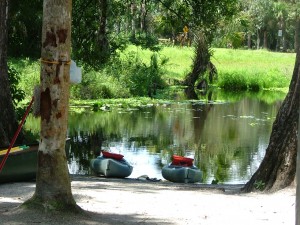
When we arrive, Mike always has the Loon 111s waiting at the water’s edge, with orange life jackets and heavy duty plastic paddles ready to go, inside the kayaks. We pack our Camelbak water packs behind the seat, along with our insulated water-proof lunch bags and padded stadium seats, making sure we have our camera and binoculars.
The new routes
Riverbend Park has been undergoing a renovation project over the last several years, adding new routes for hiking, bike riding, and kayaking, along with picnic and wildlife viewing areas. We’ve never explored the new sections, as the kayak routes weren’t open too long before we left on our bike trip, and the water was too low to kayak when they finally opened.
On our most recent trip we decided to head south and do a bit of exploring in the new areas. Mike had explained where we need to beach our kayaks and drag them up over the bank to put in at the new routes, but we missed it on the way out, so we leisurely explored some of the other pathways.
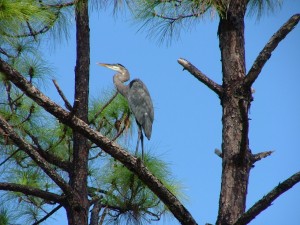
With no shade canopy in this section, no breeze, and temperatures approaching 110-115 real feel, we weren’t too inclined to spend time here, but we did enjoy seeing the thatched huts on the “islands”, and the bridges over the water. A big bonus was seeing a majestic great blue heron up in a cypress tree, quietly checking us out as Chelsea got some photos.
Mike assures us that this area is beautiful, so we’re waiting for cooler weather to do more exploring, especially now that we know where to portage over to the new routes. We’ve still been having record heat here in South Florida, though the real temperatures have been dropping. It looks like next week we finally get normal temps, so we may be planning a kayaking trip soon.
That day we headed back to the launching place at Canoe Outfitters, then headed upriver (downstream) toward our favorite spots.
The river routes and rest stops
The Loxahatchee flows north till it empties out into the Atlantic Ocean at Jonathan Dickinson State Park in Jupiter. Within a few minutes of leaving the launching area we float under the new stone bridge crossing the river, part of the ongoing development project. Another minute or two brings us to an old and unused foot bridge crossing overhead. Yet another few minutes brings us to a crossing where we turn right and soon paddle under Highway 176.
Along the way to the river’s final ending point at Jonathan Dickinson we cross two dams – the “first dam” and the second dam, known as Masten Dam. During high water times we float right over these, but each dam has ramps to pull the kayaks over when the water is low.
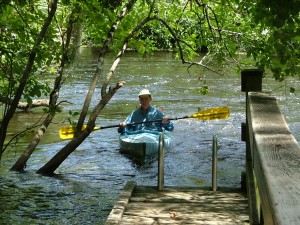
It’s always a bit exciting when the water level changes; one time, not wanting to get out and drag my kayak over, I high-centered on the first dam (I was the first one over). After Chelsea dragged her kayak up on the ramp, I had her extend a paddle so I could pull myself over to the ramps and tug myself along till I was over the dam.
Other times the water is so high that it’s only a big ripple going over the dam.
Masten Dam is a much bigger drop, and many a kayaker has flipped over trying to make it successfully across. It takes a bit of concentration and focus to line up with the opening, get enough speed up, then keep your balance while actually crossing the drop. The water flow speeds up quite a bit on the other side, so it’s important to keep the kayak straight.
For many years there was a fallen tree just on the other side of the dam, sticking out into the pool created by the dam. That tree was a kayak trap, lying in wait. Back when we kayaked on weekends, it was hilarious watching the over-confident newbies attempt the dam and flip on the other side. It’s not dangerous at all, unless you can’t swim, in which case you probably ought to not be out in the kayaks anyway.
I got my payback one beautiful Saturday when I was out kayaking with my oldest son Paul and his wife, Denise, along with my four-year-old grandson Chandler. Denise had never been kayaking; Paul and Chandler had very little experience. I went over the dam first – the water was high and flowing really fast; the day was busy so the portage ramps were loaded with people hanging out.
As I cleared the dam, I turned around to watch Paul and Denise in their double kayak; it was just enough time to lose my focus on where I was going. I hit that fallen tree, tilting just enough to breach the water, and it was all over – I was down for the count. It was spectacular – the kayak, my hat, and my lunch were floating quickly downstream while I splashed and thrashed and choked, trying to swim over to the bank. Chelsea still wishes she’d been there to see my sensational flip in front of all those people.
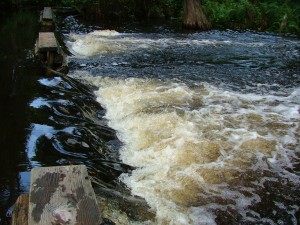
Most kayakers stop at Masten Dam; it’s a nice few hours round trip, it’s quick going downstream but the current can get pretty strong going back, making for a tiring return trip. Beyond the second dam the river gets a bit wilder; Canoe Outfitters maintains only to the second dam with the Park System responsible for maintaining the rest of the route through to Jonathan Dickinson State Park.
The state system does very little in the way of maintenance, so the area after Masten Dam has more obstacles, with more fallen trees that aren’t cleared out; it usually requires a fair amount more skill and work to negotiate the river. Added to the increased difficulty of paddling is the fact that it’s that much longer a trip back to Canoe Outfitters, all against the current.
For the brave folks with more time, Canoe Outfitters offers a trip all the way to Jonathan Dickinson Park. Rent a canoe or kayak, paddle your way to the state park, and they’ll come and pick you up, ferrying you and your kayak back to the starting place on a big old ex-school bus, but only on weekends.
One winter day (meaning beautiful Florida weather) the whole family took the long trip; Chelsea, Alex, Paul, Denise, Chandler and I hopped in our kayaks and paddled the whole way. We loved the first part, the part where it was still narrow and winding through the cypress and oak trees, with a deep shade canopy.
We didn’t like the part where we joined the big part of the river and started sharing the waterways with bigger boats. The scenery wasn’t as pretty, it was significantly hotter with no shade, we had to watch for big boats, and we were paddling against a rising tide. We made it in record time, and we’re very glad we did it, but we’ve never been inspired to do it again.
Chelsea’s and my favorite trips are to Governor’s Dock and Trapper Nelson’s.
Governor’s Dock
Governor’s Dock is an additional hour’s paddle from Masten Dam. You’ll never find it if you don’t know where it is – we tried for several months to find the small entrance off the main river; it was finally just luck and a love of exploration that allowed us to find it.
Tucked in a small cove off the main river, Governor’s Dock was originally built for a political campaign. The story has it that Lawton Chiles, a former governor of Florida, was running on an environmental campaign. To illustrate his concern and show his commitment to Florida’s natural beauty, he staged a photo op press conference. The problem was that he didn’t want to canoe the whole way into the “wilderness”. The answer was to construct a small dock a short way down the river.
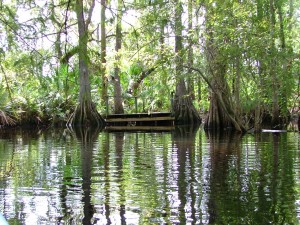
He could arrive by car on Interstate 95, hop in a canoe, paddle about twenty minutes downriver, get out on the dock and have photos taken, leaving by helicopter. To do this, the dock was built and the entire area behind the dock was clear-cut to allow for the press vehicles and helicopters.
Today the only thing that remains is the original dock and the clearing. The area behind the dock has gradually filled in a bit, but it’s still never regained its pre-clear-cutting status. We love the feeling of remoteness here; only once in our entire time of kayaking every week (seven years now except for our bike trip absences) have we ever seen anyone else anywhere near this spot.
We gradually discovered that an old fallen tree on the left side of the bank points straight in at the entrance to the cove; when we reach it we need to make a sharp right-hand turn. If the river is low, we usually have to negotiate a stubborn clog of branches at the entrance to the cove, but once we get beyond that it’s smooth paddling.
On our Governor’s Dock days, we head out early, to be the first ones on the river. We make a game of seeing how quiet we can be, the better to see the wildlife. We clear the first dam, we may take a quick rest at Masten Dam, then we head out towards the Turnpike and I95 bridges, another half hour. Governor’s Dock is a good half hour beyond the bridges; the river is usually clogged with fallen trees and tree branches.
We’ve learned to bring good lunches, a lot of water, and our padded stadium seats. We pull up to the dock, wedge our kayaks among the cypress knees, and settle ourselves onto the dock. Over the years we’ve seen deer, otter, wild pigs, squirrels, raccoons, a wide variety of birds, and we’ve watched a family of alligators that claims the Governor’s Dock cove as its home.
Our peaceful times at Governor’s Dock created some of the most relaxing and wonderful memories in our lives, despite the fact that we still had a stiff three-hour paddle back against the current.
Trapper Nelson’s
An hour farther downriver from Governor’s Dock is Trapper Nelson’s. The section of river between Governor’s Dock and Trapper’s is wilder and prettier, with a better chance of seeing more wildlife. It’s even less maintained, so the trip is often more difficult, with fallen logs to traverse and huge tree branches to avoid.
Trapper Nelson is a local legend. A New Jersey native, he arrived in Jupiter in 1929 riding the rails as a hobo. With a shrewd business sense and an eye for real estate, he gradually acquired up to eight hundred acres of land, much of it on the Loxahatchee River. He eventually built a camp on the Loxahatchee, complete with a wild animal exhibit, building the entire thing with only hand tools.
Trapper Nelson lived exclusively off the land, hunting, fishing and trapping. With a reputation as a flamboyant character, frequently called the Tarzan of the Loxahatchee, he’d entertain tourists by wrestling alligators. Wearing only shorts and a bandana, he’d swing out of the trees and land in the water near the touring boats. After landing, he’d swim over to the boat and negotiate docking fees.
An impressive figure at six-feet four-inches tall and two hundred forty pounds, Trapper Nelson had an eye for beautiful rich women, often entertaining celebrities and well-known heiresses.
By the early sixties he became suspicious and reclusive, gradually withdrawing more and more. In July of 1968 he was found dead of a shotgun wound. Mystery still surrounds his death – those who knew him well feel to this day that he was murdered, but his death was officially ruled a suicide.
After his death the state of Florida acquired his lands. His cabin, outbuildings and property have been left as they were the day he died. It’s still accessible only by boat; canoeists, kayakers and pontoon tour boats come from Jonathan Dickinson State Park; far fewer kayaks and canoes reach it from Riverbend Park.
After paddling for a steady three hours or so, the dock at Trapper’s is a welcome sight. We tie our kayaks up at the dock, then have lunch under the “chichee” a rudimentary shelter inspired by the shelters of the Seminole Indians. Trapper Nelson used the chichee for his own shelter as he worked on building his cabin and outbuildings.
On our first visit to Trapper’s, a tour boat arrived shortly after we did; the park ranger invited us to tag along and listen. The tour was well done – very informative and entertaining; we learned a tremendous amount about the history and times when Trapper was there.
Having spent three hours paddling alone on a beautiful solitary river, then having lunch under the hand-hewn chichee on land that hasn’t changed in sixty years, we felt as though we’d somehow walked through a window into a former time.
The tidal influence starts making its presence known at this point, especially closer to Trapper Nelson’s. On our second visit we’d stayed long enough that the tide started going out; the water level at the dock had dropped so much we discovered our kayaks were literally hanging by their bungie cords.
Fighting the current upstream and against a dropping tide was really a challenge. Many of the trees and branches that had been submerged when we’d come downriver were now exposed, making the route even more difficult as we dragged our kayaks up and over the obstacles, balancing carefully on slippery logs.
The roundtrip from Riverbend Park to Trapper Nelson’s and back takes us about seven hours, counting several rest stops on the way back. It’s quite a workout; we sleep really well that night, and we feel it in our muscles the next day. It’s a trip we can’t do without working up to it by doing a number of trips to Governor’s Dock first, but it is so well worth the effort!
Sights and people on the river
Over the last seven years we’ve spent a lot of time on the river, seeing a lot of things in the process. One summer the alligators simply disappeared. Eric, the owner of Canoe Outfitters, kept asking if we’d seen any, and for six weeks we told him nope, no alligators. That was the year we got hit with three major hurricanes within a month. We now know to head out of town when the alligators disappear.
One of our major annoyances and sources of amusement at the same time are the other kayakers and canoeists on the river. While many are respectful of the river and the wildlife, some are not, especially the weekend crowd.
We see them bouncing off every bank, getting trapped in cypress knees, cruising along with boom boxes blasting and beer flowing freely, bouncing off each other. Frequently when they see us they’ll shout out, “Hey, you seen any alligators up there? We haven’t seen any! We thought there were supposed to be alligators here!”
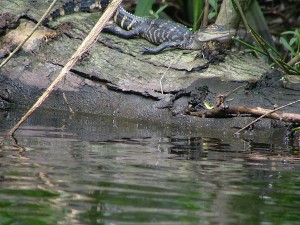
I used to just shrug and say no, but now I press a finger to my lips in the classic signal for silence, and I’ll say sotto voce, “Yes, there’s a big ten-footer up ahead! Be really quiet and you might see it!” The truth is that there usually is a gator…they’d just never see it with all that noise and commotion.
The last time we were on the river we were the first ones out, luxuriating in the early morning silence. I was a few turns ahead of Chelsea, so I pulled into a little turnout, hanging on to a cypress knee till she caught up to me. In only a minute or so I saw her, looking flustered and ‘hunted’. I soon saw why.
Immediately behind her was a guy in a kayak powering his way through the water as if he were in a race and Chelsea was blocking him from getting first place. He looked as though he would kayak right up over her. She pulled over as soon as she could, and he roared on by with a dive knife strapped to his thigh, wielding his paddles as if there were no tomorrow. Chelsea told me that with his fierce paddling style he was making so much noise behind her that she thought he was a huge animal crashing through the bushes.
We ran into him a few minutes later down at Masten Dam. Turns out he’s a charter airline pilot who works for a private individual, flying wherever the boss needs to go. The pilot loves the exercise he gets on the river, and goes out as often as he can, if necessary fitting his exercise time into only an hour or so the morning of a flight. He’s interested in the exercise, in going fast, in getting a stiff work-out, and not in the wildlife, so being quiet with his paddling style isn’t something he thinks about.
Life is all about individual preferences, and since we dearly love the silence and the wildlife, we’ve learned that we need to go as early in the day as we can, be there when Canoe Outfitters opens, and get at least a half hour head start on the river.
Ant bites
We were so tired last time on the river after our really long work days that we stopped at Masten Dam for our end point instead of going on to Governor’s Dock. The heat and humidity were particularly obnoxious – even the birds and gators and animals seemed to be in hiding. About all we’d seen were a few turtles sunning themselves and sturdy spider webs glistening in the sun, looking as efficient and durable as mini utility lines running off into the distance.
Chelsea headed off to the outhouse while I waited with the kayaks. I could have gotten out on the portage ramps, but they were in very hot direct sun; the only spot available in the shade was a rock next to my kayak. On an earlier trip I’d sat there and gotten some nasty ant bites on a very tender part of my anatomy, as had Chelsea and another woman we’d met there, so I wasn’t going to be fooled into sitting there again.
I opted for staying in my kayak and eating my lunch. Finally needing to stretch, I wiggled around to get into a good position for getting out of the kayak, carefully stretching my leg out over the kayak onto a rock under the water.
I misjudged the angle of the kayak, the slipperiness of the rock, and my angle; after a bit of frantic arm waving to regain my balance, over I went backwards. The water was much deeper behind the rock, so I couldn’t get purchase on anything – I was trapped with my legs up ahead of me on the rock and no way to balance myself on the backside.
After thrashing about, I finally grabbed the rock on the bank, regained my footing and stood up, soaked to the bone, just as a young couple pulled up on the other side of the dam. Chelsea arrived a minute later to find me soaking wet, embarrassed, and annoyed. The only bright spots were that I didn’t have anything in my pockets to get wet, and my wet clothing would be cooler on our hot paddle back.
We finished lunch, dragged our kayaks up over the ramp and headed back. Within a few minutes I felt a stinging sensation on my right thigh. My heart sank as I recognized the feeling as being an ant bite. I ignored it, knowing that it would probably be bad for a few minutes but then fade out. No such luck. I soon felt the stinging inside my shirt, on my lower rib cage.
Less than halfway back I finally pulled off to the side to wait for Chelsea, desperate for help. By this time the stinging was covering my upper rib cage, the back of my neck, and my collarbone. I realized that I had probably gotten into the ants that had been on that rock back at the dam, when I fell, and they were now crawling inside my shirt, biting me. Chelsea did what she could, but the ants were absolutely microscopic; it didn’t take long to realize that I would have to tough it out and just get back.
That was a very long paddle back. By that night I had at least eight distinct patches of bites, with about fifteen bites per patch. I couldn’t even bear to have clothing touch them. Thanks to regular applications of Wounded Warrior the worst was over in about three days, but I’ll remember that sinking feeling for a long time…
“Our” river
We’ve spent so much time on the Loxahatchee over the last seven years, most of it with no one else around, and we’ve had so many adventures, big and small, that we’ve come to think of it as “our” river.
We kayaked it for two years before the hurricanes of 2004 and after the devastation the hurricanes wrought. We’ve seen it with such high water that it’s almost impossible to tell where the river really is; we’ve seen it with so little water that we had to drag our kayaks over long stretches of sand.
We’ve seen it with a rich full shade canopy, then traversed its length with no shade at all after the hurricanes. We’ve known it long enough that we’ve now seen the re-growth of the shade canopy and the underbrush.
We’ve had so many adventures over the years on the river that it would take hours to tell them all. Our memories have become woven into a rich tapestry; our thoughts of time on the river give us a great joy.
We’ve traveled extensively over our lifetimes, seeing many extraordinary sights along the way, but there’s never been anything to match our trips on our beloved river. When asked what we miss about being home, besides our family here, we’d say, “the Loxahatchee River”.
